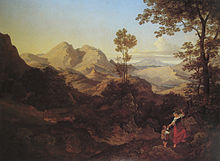Ernst Fries
Ernst Fries (born June 22, 1801 in Heidelberg , Electoral Palatinate , † October 11, 1833 in Karlsruhe , Grand Duchy of Baden ) was a German landscape painter in the transition from Romanticism to Realism . He was buried in his native Heidelberg.
Life

Ernst Fries was born in Heidelberg as the son of the banker, factory owner of Färberkrapp and painting collector Christian Adam Fries . His father's love for art and the affluent circumstances in his family made it possible for him to receive an artistic education and to paint and travel without financial worries. His two brothers, Wilhelm and Bernhard Fries , born almost twenty years later , also became painters.
From 1810, Ernst Fries, together with Karl Philipp Fohr and Carl Rottmann, received lessons from Friedrich Rottmann, the father of Carl Rottmann, "University Sign Master" in Heidelberg. From 1815 on, Ernst Fries received lessons from Karl Kuntz in Karlsruhe. In 1816 he continued his studies in Munich. In 1818 Fries came to Darmstadt, where he trained in perspective and architectural drawing with Georg Moller .
Over the years, Fries turned more and more to landscape painting . In 1820/21 he studied at the Munich Academy . Ernst Fries traveled to the Rhineland, Tyrol and Salzburg. From 1823 to 1827 he went on the classic study trip to Italy. From 1823 to 1827 he lived in Rome . After returning home, he stayed in Munich, but in 1831 he returned to Karlsruhe , near his home in Heidelberg, where he had been appointed court painter to the Grand Duke of Baden.
Ernst Fries died of suicide in Karlsruhe in 1833. His tomb today is a synthetic resin copy that replaced the crumbling original sandstone grave complex. It shows an antique sarcophagus in the shape of a house, which is reminiscent of the funerary monument of Jean Jacques Rousseau.
plant
During his time in Rome, Fries undertook extremely productive journeys together with various artist friends, which made him a good expert on the closer and wider surroundings of Rome and southern Italy. Here his art was fulfilled and his extraordinary talent for coloring came to light. His Italian landscapes are characterized by a poetic conception of nature and a stylized treatment of its forms, they are drawn in detail, with warm, strong, harmonious coloring. You appear calm and are largely free of romantic pathos. This and the use of clay colors in a loose, fluid application indicate the incipient realism in landscape painting.
The works of the prematurely deceased, oil paintings, watercolors, drawings and prints, are among the best in German art of the early 19th century. Together with Carl Rottmann and Karl Philipp Fohr, Ernst Fries formed the picturesque center of Heidelberg Romanticism . A rich collection of drawings, sketchbooks and engravings is privately owned by a descendant in Germany. His paintings are represented in various museums, e.g. B. the large picture galleries and graphic collections in Hamburg, Berlin, Dresden, Leipzig, Frankfurt, Darmstadt, Karlsruhe, Schweinfurt Museum Georg Schäfer , Munich and the Museum Oskar Reinhart in Winterthur. The Palatinate Museum in Heidelberg with about 180 works of the most comprehensive collection of works by Ernst Fries. Large special exhibitions were held there in 1927, 1972 and 2001/2002.
literature
- Friedrich Pecht : Fries, Ernst . In: Allgemeine Deutsche Biographie (ADB). Volume 8, Duncker & Humblot, Leipzig 1878, p. 72 f.
- Ernst Fries. Heidelberg 1801 - 1833 Karlsruhe. Exhib. Cat. Ed. Frieder Hepp u. Annette Frese. Museum of the Electoral Palatinate of Heidelberg. October 28, 2001 - January 13, 2002. Heidelberg: Kehrer Verlag 2001
- Sigrid Wechssler: Ernst Fries (1801–1833). Monograph and catalog raisonné . Heidelberg: Kehrer Verlag, 2000.
- Jens Christian Jensen: watercolors and drawings of the German romanticism . DuMont Buchverlag, Cologne 1992, ISBN 3-7701-0976-7 , p. 165.
- Matthias Lehmann: Nature studies - legacy - fame. The estate file of the landscape painter Ernst Fries (1801–1833) . Fichter, Frankfurt am Main 2013, ISBN 978-3-943856-04-0 .
- Arthur v. Schneider: Fries, Ernst. In: New German Biography (NDB). Volume 5, Duncker & Humblot, Berlin 1961, ISBN 3-428-00186-9 , p. 604 ( digitized version ).
Web links
- Literature by and about Ernst Fries in the catalog of the German National Library
- Picturesque journey on the Moselle from Coblenz to Trier. Drawn from nature by Fries… - Heidelberg: Engelmann, [1821]. Online edition dilibri Rhineland-Palatinate, 2009
- Picturesque views of the Rhine, Moselle, Haardt, and Taunusgebürges. Signed von Fries… - Heidelberg: Engelmann, [approx. 1820]. Online edition dilibri Rhineland-Palatinate, 2009
Individual evidence
- ^ Friedrich Noack : The Germanness in Rome since the end of the Middle Ages . Deutsche Verlagsanstalt, Stuttgart 1927, Volume 2, p. 191
- ↑ L. Ruuskanen: The Heidelberg Bergfriedhof through the ages . (Publishing house regional culture, 2008)
| personal data | |
|---|---|
| SURNAME | Fries, Ernst |
| BRIEF DESCRIPTION | German landscape painter |
| DATE OF BIRTH | June 22, 1801 |
| PLACE OF BIRTH | Heidelberg |
| DATE OF DEATH | October 11, 1833 |
| Place of death | Karlsruhe |

